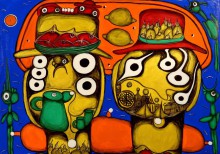The uncanonical painting of Emma Andijewska (Andiievska), invisibly tied up with the willful whirlpools of the author’s existence, poses a real esthetic mystery to many spectators. A commonplace person may find it totally impossible to interpret every subject or symbol of her pictures. Searching for a “grain of truth” in the outlandish and grotesque imagination world of a unique painter and poetess, anyone may well get lost in the unusual surroundings and ask other wayfarers to help trace the sources of this metaphorical road.
Emma Andijewska, one of the most brilliant artistic individualities of today, is really “merciless” as well as candid. The mistress has been nominated for the Shevchenko Prize for the books Cities-Jacks, Clockless Time, Landscapes in the Drawers, Marathon, and Everyday Life: Periscopes.
Andijewska is undivided in her passions and categorical in her judgments; she is a bold pioneer on the paths of verbal and visual forms that shape her inimitable disposition; she continues to captivate and surprise, creating painting cycles with an unheard-of speed. For Emma, the very strategy of painting radically differs from the methods of the vast majority of artists who plan, sketch, and sometimes rack their brains over the choice of formal instruments to implement a pre-considered idea. This path would run counter to Andijewska’s inner nature. She has been painting since she began to write poems and short stories, stubbornly overcoming stereotypes and the slightest hesitations about any “academic rules” in art. She paints when the reactor of her existence generates a great deal of energy which is to be put into a structured poetic or painting form. Therefore, Andijewska has been revealing her own world-view for many decades in two concurrent dimensions, which shapes her integral poetic and philosophical image.
It is rather difficult to systemize Andijewska’s artworks (thousands of pictures and drawings) in terms of genres and formal expressive means. It is a good idea to scrutinize her art in the dynamics of the author’s passion in general, when certain associations were being born, senses were forming, new ways of mental organization were being sought. From the first solo exhibit in Munich (1956) until the next one in New York (1989), poetry and prose books were outrunning paintings, but that period saw the birth of a large number of allegoric characters which filled the mystifying author’s subjective reality all over the space of her artistic experiences. By the late 1980s the ratio of painting had risen so much that Andijewska began to produce not only poetic books, but also what can be called “visual poetry albums,” with due account of the genres and themes of those publications.
What are these books about, why are they important to the authoress, and how can we qualify Andijewska’s painting canvases? To answer these questions, one should abstract away again from customary approaches to other artists’ painting practices. The motivational factor for the artist is not setting a certain professional goal but expressing something that is immanent, specific, and typical of the author’s existence, of a certain emotional condition, or irrational in the metaphysics of time or place. Undoubtedly, the world order in Andijewska’s artistic space derives from her mythological thinking and is kept afloat by a specific poetic world-view and a sharp visualization of the invisible.
Whenever you want to systemize the themes and genres of Andijewska’s paintings, you face the following problem: where, when, and how did the basic form emerge – the form that gave birth to characters, objects, and some quaint creatures with which the authoress models certain mythological plots? Naturally, fictional images are neither concretely emotional, nor decorative, nor provocative. And their symbolism is also entirely different from the classical interpretation of this historical art term. The “population” of Andijewska’s imaginary world is, above all, kindhearted (the mirror reflection of the authoress’ value-oriented imperative). The artist “describes” with a shade of humor her daily routine and hyperbolizes secondary (by the hierarchy of meanings) details. In the 2001 issue of the Munich-based publication In Bild, prepared together with German photo artist Lisa Pfahler-Scharf, Emma shows self-portrait-style paraphrases with her own pictures, which proves organicity of the cherished poetic world with her personal lifestyle, character, self-irony, and burlesque. It is not necessary to call all the elements of this plastique syntax skillfully designed in both light and color. Round shapes developed into the formless masses of figures and heads that featured “wrongly” set kind and sorrowful eyes. Hermetic dynamic structures, reinforced with an expressive color, became the “banquet” of the painting temperament of Andijewska as a self-sufficient poetess and artist who is frank in her judgments and creative manifestations.
At the same time, Andijewska changes the structure of a metaphysical environment in another group of pictures, expressing more complicated philosophical senses. It is particularly noticeable in the “Crucifix” cycle of drawings (2014-15), where a New Testament subject is treated in a rather unexpected way, and in “The 1,001st Night” (2008-10). Yet, regardless of the thematic factor in painting, graphic artistry, and carpet-making, which the artist also turns to, one can always see the sign of magic which combines the various states of her existence, the different levels of reacting to life, the different intonations of joy and sadness that accompany the life path of a great Ukrainian lady. By conceptual indications, the art of Emma Andijewska draws remote formal parallels with abstract expressionism, lyrical abstraction, and informalism (art informel), but none of these art trends in the second half of the 20th century comprises a concentrated poetic component which is the quintessence of the phenomenon of Andijewska – an inimitable and unsurpassable person on the all too complex platform of world perception.
Roman Yatsiv is a pro-rector of the Lviv Academy of Arts








